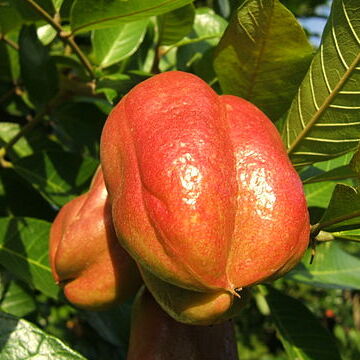Trees or shrubs. Stipules wanting. Leaves alternate, paripinnate, rachis with a distal process (rudimentary leaflet); leaf rachis cylindrical or angled; petiolules short and slightly swollen; leaflets opposite, 1-5 pairs, the margins entire. Inflorescences axillary racemes or racemose thyrses with depauperate dichasia. Flowers actinomorphic, functionally unisexual (plants polygamous-dioecious); calyx of 5, free, valvate sepals; petals 5, connate along the margins to a petaloid appendage, forming a pouch; disc annular, 8-lobed; stamens 8-10; ovary 3(4)-carpellate, with a single ovule per carpel; style distal, elongate-conical. Fruit a 3(4)-locular, loculicidal, capsule. Seeds with a basal, enlarged aril.
Large, polygamous trees. Leaves sparse, exstipulate, petiolate, paripinnate; leaflets entire, pinnately veined. Inflorescences axillary, racemiform, the bracte-oles small, buds subconical. Flowers narrowly pedicellate; calyx 5-parted, the lobes ovate-lanceolate, narrowly imbricate; petals 5, linear-lanceolate, bearing scales within from near the base; disc swollen, somewhat 8-lobed; stamens 8, inserted within the disc; ovary 3-locular, 3-carpellate. Fruit 3-locular, large, trigonous-pyriform; seeds arillate.
Fruit a 3-lobed, narrowly to moderately 3-winged, 3-locular loculicidal capsule.
Inflorescence an axillary usually racemoid thyrse (often partially racemose).
Seeds 1 in each loculus, with a fleshy arillode surrounding the lower part.
Petals 5, pouchlike owing to the fusion of the margins of the scales.
Flowers spuriously polygamous, usually dioecious, actinomorphic.
Ovary 3-gonous, 3-locular; loculi 1-ovulate.
Leaves paripinnate; leaflets 1–5-jugate.
Large trees or shrubs.
Sepals 5, connate.
Stamens 8–10.
Disk lobed.

